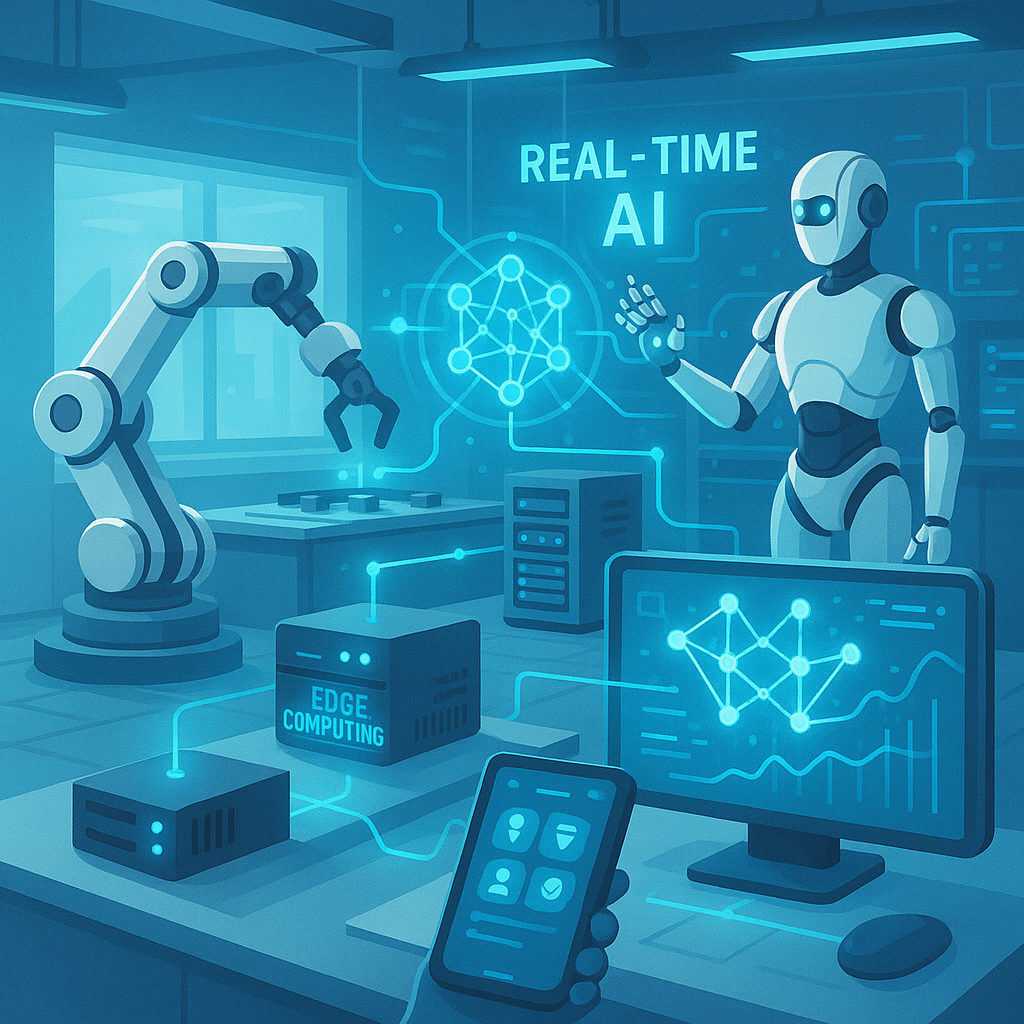In today’s quick-changing robotics field, quickness and precision mean everything. A drone finding its way in real time, a robot arm sorting packages, or a self-driving car deciding in a flash all need one thing: real-time control is a must.
This is where the strong team of Artificial Intelligence (AI) and Edge Computing steps in. Working together, they’re changing how robots think, choose, and act—right away.
🧠 What Does AI Mean in Robotics?
AI in robotics involves teaching machines how to “think” and choose based on data. Here are some examples:
- A robot can spot objects using computer vision
- It can figure out its next move using machine learning
- It can adjust to shifts in its surroundings right away
But all this brain power needs to happen fast—which leads us to our next point.
⚡ The Issue with Cloud-AI
In the past many AI systems ran on the cloud. Data from the robot went to far-off servers for processing, and then the answers came back.
This method has a big problem: delay. That lag between sending data and getting responses works for some tasks—but for split-second choices, it’s often too slow.
Picture a robot in a factory avoiding a human worker. If the information needs to go to the cloud and come back even a one-second lag could result in an accident.
🌍 What Is Edge Computing?
Edge computing fixes this problem by moving data processing nearer to the device—quite “on the edge” of the network.
Rather than sending data to the cloud, edge devices (such as smart chips or onboard computers) handle the information right where it originates—inside the robot, drone, or vehicle.
This allows decisions to happen in milliseconds, not seconds.
🚀 Why Combining AI + Edge Computing Is a Game-Changer
When AI teams up with edge computing, it leads to real-time control of robots. Here’s what this means:
1. Lightning-Fast Reactions
Robots can spot and respond to their surroundings right away, which makes them safer and more productive.
2. Smarts Without Wi-Fi
Robots can think and act without needing to be online all the time—perfect for out-of-the-way or high-security spots.
3. Less Data Traffic
Because data doesn’t travel far, it cuts down on network strain and expenses.
4. Stronger Privacy and Security
Robots can handle sensitive info (like video feeds or location data) right where they are cutting down on privacy concerns.
🏭 Real-Life Examples
✅ Manufacturing
Clever robots on production lines can spot flaws, change their behavior, or steer clear of crashes without needing cloud feedback.
🚗 Self-Driving Cars
Cars that drive themselves use AI at the edge to spot lanes, traffic, people walking—and respond right away to keep everyone safe.
🛸 Drones
Drones apply AI and edge computing to find their way, dodge things in their path, and keep an eye on objects as they happen—even in spots with no Wi-Fi.
🏥 Healthcare Robots
Robots helping in surgery or looking after patients use AI at the edge to move with pinpoint accuracy making sure everything’s safe and on target.
🧩 Tech That Makes This Happen
- NVIDIA Jetson, Intel Movidius: Small edge processors that handle AI tasks in real time
- TensorFlow Lite ONNX Runtime: Streamlined AI models designed to work on edge devices
- ROS 2 (Robot Operating System): A versatile framework that helps deploy AI at the edge
📈 What This Means for the Future
The combination of AI and edge computing is ushering robotics into a new age of quickness, self-reliance, and smarts. Robots aren’t just machines following set instructions anymore—they’re evolving into systems that can reason and act .
As these technologies advance, get ready for homes that think, workplaces with better safety, supply chains that run smoother, and even cities that outsmart themselves—all thanks to robots equipped with AI that works right where it’s needed.
